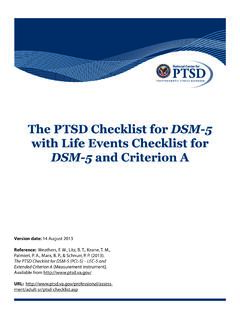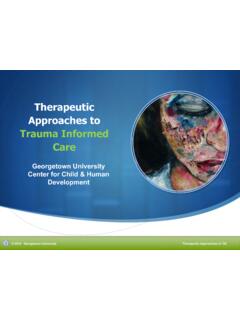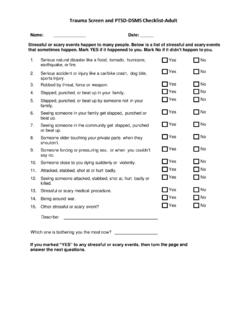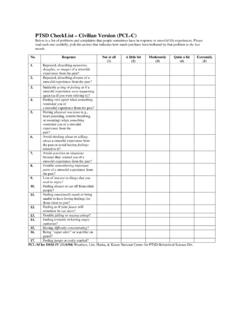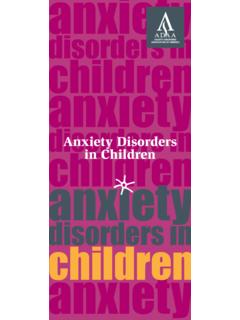Transcription of Using the PTSD Checklist (PCL)
1 Using the ptsd Checklist (PCL) What is the PCL? The PCL is a 17-item self-report measure of the 17 DSM-IV symptoms of ptsd . The PCL has a variety of purposes, including: Screening individuals for ptsd . Diagnosing ptsd . Monitoring symptom change during and after treatment. There are three versions of the PCL: 1. The PCL-M (military) asks about symptoms in response to "stressful military experiences." It is often used with active service members and Veterans. 2. The PCL-C (civilian) asks about symptoms in relation to stressful experiences. The PCL-C is useful because it can be used with any population. The symptoms endorsed may not be specific to just one event, which can be helpful when assessing survivors who have symptoms due to multiple events.
2 Typically, it is optimal to assess traumatic event exposure to ensure that a respondent has experienced at least one Criterion A event. 3. The PCL-S (specific) asks about symptoms in relation to an identified "stressful experience." The PCL-S is useful because the symptoms endorsed are clearly linked to a specified event. Typically, it is optimal to assess traumatic event exposure to ensure that the event meets Criterion A. Respondents also may be instructed to complete the PCL-S in reference to a specific type of event. How is the PCL Administered and Scored? The PCL is a self-report measure that can be completed by patients in a waiting room prior to a session or by participants as part of a research study. It takes approximately 5-10 minutes to complete a PCL. Interpretation of the PCL should be completed by a clinician. The PCL can be scored in different ways: A total symptom severity score (range = 17-85) can be obtained by summing the scores from each of the 17 items.
3 A diagnosis can be made by: 1. Determining whether an individual meets DSM-IV symptom criteria, , at least 1 B item (questions 1-5), 3 C items (questions 6-12), and at least 2 D items (questions 13-17). Symptoms rated as Moderately or above (responses 3 through 5) are counted as present. 2. Determining whether the total severity score exceeds a given cutpoint (see Table 1). VA National Center for ptsd June 2010 Page 1 of 2 Using the ptsd Checklist -May 2010 3.
4 Combining methods (1) and (2) to ensure that an individual has sufficient severity as well as the necessary pattern of symptoms required by the DSM. How can PCL Scores be Interpreted? Characteristics of a respondent s setting should be considered when Using PCL severity scores to make a diagnosis. The goal of assessment also should be considered. A lower cutoff should be considered when screening or when it is desirable to maximize detection of possible cases. A higher cutoff should be considered when attempting to make a definitive diagnosis or to minimize false positives. Suggested cutoffs are presented below. Table 1. Suggested cutoff scores for screening and diagnosis. Goal of Assessment Setting Screening Diagnosis VA ptsd specialty mental health clinic1 48 56 VA Primary Care clinic1 25 33 Active duty Iraq/Afghanistan (OEF/OIF)2 25 28 Civilian substance abuse residential3 36 44 Civilian primary care4-5 25 30-38 Civilian motor vehicle accidents6 44 50* *Note that Blanchard et al.
5 (6) chose a cutoff score of 44 for diagnosis based on diagnostic efficiency. However, the psychometrics they presented for a cutoff score of 50 yielded optimal sensitivity and specificity. Measuring Change Good clinical care requires that clinicians monitor patient progress. Evidence suggests that a 5-10 point change represents reliable change ( , change not due to chance) and a 10-20 point change represents clinically significant change. Therefore, we recommend Using 5 points as a minimum threshold for determining whether an individual has responded to treatment and 10 points as a minimum threshold for determining whether the improvement is clinically meaningful. References 1. Prins, A., Kimerling, R., Yeager, D. E., & Magruder, K. M. (2010). Guidelines for interpreting PCL scores in VA settings: An interval approach. Manuscript in preparation. 2. Bliese, P. D., Wright, K. M., Adler, A. B., Cabrera, O., Castrol, C. A., & Hoge, C. W. (2008). Validating the primary care posttraumatic stress disorder screen and the posttraumatic stress disorder Checklist with soldiers returning from combat.
6 Journal of Consulting and Clinical Psychology, 76, 272-281. 3. Harrington, T., & Newman, E. (2007). The psychometric utility of two self-report measures of ptsd among women substance users. Addictive Behaviors, 32, 2788-2798. 4. Walker, E. A., Newman, E., Dobie, D. J., Ciechanowski, P., & Katon, W. (2002). Validation of the ptsd Checklist in an HMO sample of women. General Hospital Psychiatry, 24, 375-380. 5. Sherman, J. J., Carlson, C., Wilson, J. F., Okeson, J., & McCubbin, J. A. posttraumatic stress disorder among patients with orofacial pain. Journal of Orofacial Pain, 19, 309-317. 6. Blanchard, E. B., Jones-Alexander, J., Buckley, T. C., & Forneris, C. A. (1996). Psychometric properties of the ptsd Checklist (PCL). Behavioral Research & Therapy, 34, 669-673. 7. Weathers, F., Litz, B., Herman, D., Huska, J., & Keane, T. (October 1993). The ptsd Checklist (PCL): Reliability, Validity, and Diagnostic Utility. Paper presented at the Annual Convention of the International Society for Traumatic stress Studies, San Antonio, TX.
7 NOTE: Due to some confusion over versions of the PCL, some of the published papers state that the PCL-C was used in this study, but the authors have confirmed that the PCL-S was the version actually used. VA National Center for ptsd Page 2 of 2
